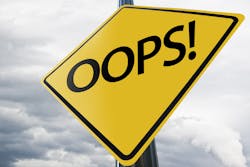Brad and Michelle have been on trouble call overload all week. An unexpected shutdown and restart failure brought them to a critical line. They determined a motor needed replacement, partly because Michelle smelled the burned windings almost as soon as she got there.
After replacing the motor, they found voltage imbalance and power factor within limits. So, they figured the motor had just gone bad, maybe the winding insulation had been damaged during manufacture. They aligned the new motor, attached the vibration sensors, and put it back in service.
Shortly after they arrived at the next trouble call, the operator they’d just left approached them. The new motor was turning, but something wasn’t right so he shut it off.
Back at that motor, the operator explained that he’d put his hand on the drive gearbox on the load side of the motor to feel for vibration and had nearly burned himself. Further investigation revealed the gearbox bearings had been improperly packed. This extra load had caused the previous motor to burn itself up because its thermal overloads were one size oversized. Lesson? When a motor burns up, check the whole system.
About the Author

Mark Lamendola
Mark is an expert in maintenance management, having racked up an impressive track record during his time working in the field. He also has extensive knowledge of, and practical expertise with, the National Electrical Code (NEC). Through his consulting business, he provides articles and training materials on electrical topics, specializing in making difficult subjects easy to understand and focusing on the practical aspects of electrical work.
Prior to starting his own business, Mark served as the Technical Editor on EC&M for six years, worked three years in nuclear maintenance, six years as a contract project engineer/project manager, three years as a systems engineer, and three years in plant maintenance management.
Mark earned an AAS degree from Rock Valley College, a BSEET from Columbia Pacific University, and an MBA from Lake Erie College. He’s also completed several related certifications over the years and even was formerly licensed as a Master Electrician. He is a Senior Member of the IEEE and past Chairman of the Kansas City Chapters of both the IEEE and the IEEE Computer Society. Mark also served as the program director for, a board member of, and webmaster of, the Midwest Chapter of the 7x24 Exchange. He has also held memberships with the following organizations: NETA, NFPA, International Association of Webmasters, and Institute of Certified Professional Managers.
